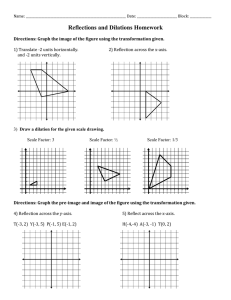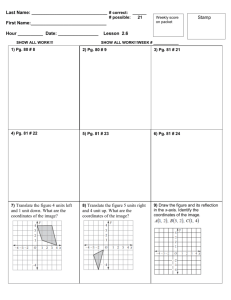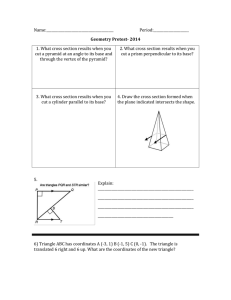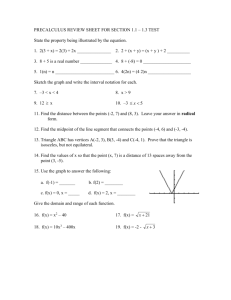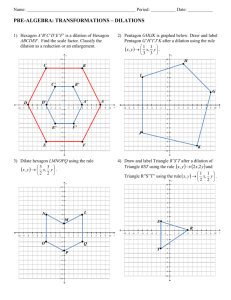Transformations:
advertisement
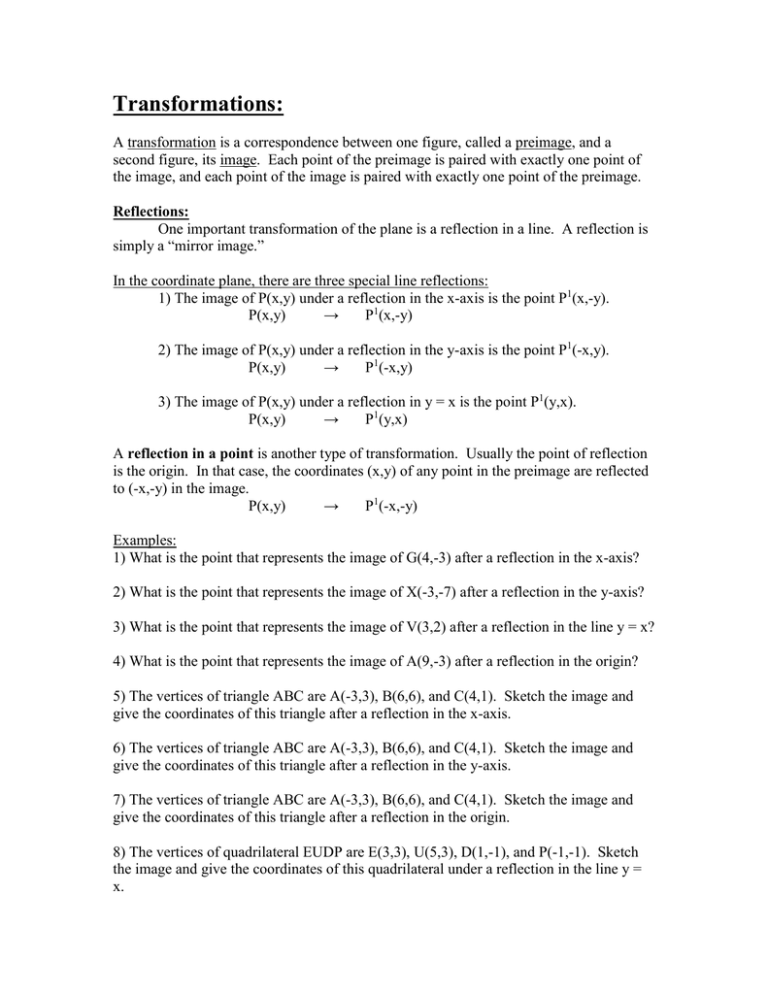
Transformations: A transformation is a correspondence between one figure, called a preimage, and a second figure, its image. Each point of the preimage is paired with exactly one point of the image, and each point of the image is paired with exactly one point of the preimage. Reflections: One important transformation of the plane is a reflection in a line. A reflection is simply a “mirror image.” In the coordinate plane, there are three special line reflections: 1) The image of P(x,y) under a reflection in the x-axis is the point P1(x,-y). P(x,y) → P1(x,-y) 2) The image of P(x,y) under a reflection in the y-axis is the point P1(-x,y). P(x,y) → P1(-x,y) 3) The image of P(x,y) under a reflection in y = x is the point P1(y,x). P(x,y) → P1(y,x) A reflection in a point is another type of transformation. Usually the point of reflection is the origin. In that case, the coordinates (x,y) of any point in the preimage are reflected to (-x,-y) in the image. P(x,y) → P1(-x,-y) Examples: 1) What is the point that represents the image of G(4,-3) after a reflection in the x-axis? 2) What is the point that represents the image of X(-3,-7) after a reflection in the y-axis? 3) What is the point that represents the image of V(3,2) after a reflection in the line y = x? 4) What is the point that represents the image of A(9,-3) after a reflection in the origin? 5) The vertices of triangle ABC are A(-3,3), B(6,6), and C(4,1). Sketch the image and give the coordinates of this triangle after a reflection in the x-axis. 6) The vertices of triangle ABC are A(-3,3), B(6,6), and C(4,1). Sketch the image and give the coordinates of this triangle after a reflection in the y-axis. 7) The vertices of triangle ABC are A(-3,3), B(6,6), and C(4,1). Sketch the image and give the coordinates of this triangle after a reflection in the origin. 8) The vertices of quadrilateral EUDP are E(3,3), U(5,3), D(1,-1), and P(-1,-1). Sketch the image and give the coordinates of this quadrilateral under a reflection in the line y = x. 9) The vertices of triangle ABC are A(-6,7), B(4,8), and C(-2,3). Sketch the image and give the coordinates of this triangle after a reflection in the line y = 3. 10) The vertices of quadrilateral ABCD are A(-4,5), B(-4,8), C(-2,3), and D(-2,6). Sketch the image and give the coordinates of this triangle after a reflection in the line x = 1. 11) The vertices of triangle ABC are A(-3,3), B(6,6), and C(4,1). Sketch the image and give the coordinates of this triangle after a reflection in the line y = -x. Translations: A translation is a transformation of a figure in which each point is moved the same distance in the same direction. Since you can imagine sliding triangle ABC onto A1B1C1, we usually call a translation a “slide.” The image of P(x,y) under a translation a units horizontally and b units vertically is given by: P(x,y) → P1(x + a,y + b) Characteristics of a Translation: 1) If a line segment is translated, the image is a line segment congruent to the original line segment. 2) If an angle is translated, the image is an angle congruent to the original angle. 3) The orientation (order of the vertices) of the image is the same as that of the original object. Examples: 1) The coordinates of the vertices of triangle ABC are (A-1,2), B(4,6), and C(3,-2). Find the coordinates of the image, triangle A1B1C1, under a translation to the left 4 units and down 2 units. 2) What are the coordinates of the point C(-5,4) after a translation of 2 units left and 4 units up? 3) Quadrilateral ABCD with vertices A(1,0), B(4,7), C(6,4), and D(5,0). Graph and sketch the coordinates after a translation of 2 units left and 2 units up. 4) What are the coordinates of the image of A(3,5) under a translation 5 units left and 4 units down? 5) A translation maps (-6,-2) onto (-4,-2). Find the image of (3,5) under the same translation. 6) Find the coordinates of the point (-1,3) after the transformation T-3,2. Dilations: A dilation with center O is a transformation in which a given figure is enlarged or reduced. Dilations in the Coordinate Plane: The image of P(x,y) under a dilation in the coordinate plane with the origin as center of dilation and scale factor k (k a nonzero real number is P1 (kx,ky). P(x,y) → P1(kx,ky) Characteristics of a Dilation: 1) Let k represent a positive real number. 2) If a segment is dilated with a scale factor k, the image is a line segment whose length is k times that of the original. 3) If an angle is dilated with a scale factor k, the image is an angle congruent to the original angle. Examples: 1) Under a dilation with center at O(0,0), the image of A(-4,2) is A1(-2,1). What is the scale factor for the dilation? 2) The vertices of triangle ABC are A(-2,1), B(3,1), and C(-2,5). Graph and give the coordinates after a dilation of 3. 3) The vertices of triangle DEF are D(-5,2), E(-3,7), and F(-5,-5). Graph and state the coordinates of triangle D1E1F1, the image of DEF after D2. 4) What are the coordinates of the point (-3,4) under D3? 5) Quadrilateral ABCD has the following coordinates: A(-2,-2), B(-1,-3), C(4,1), and D(4,-2). Graph and state the coordinates of quadrilateral A1B1C1D1, the image of ABCD after D-2. Rotations: An isometry is a transformation under which image and preimage are congruent (size does not change). Reflections, translations, and rotations are all isometries. When you translate a figure, you slide it to another position in the plane. Under a rotation in the plane, you swing a figure around in the plane using a fixed distance from a fixed point in the plane called the center of rotation. The rotation may be clockwise or counterclockwise. *** With rotations, it is assumed the direction of the rotation is counterclockwise unless it is otherwise stated. ***To determine equivalent rotations in a positive (counterclockwise) and negative (clockwise) direction, subtract the angle measure you are given from 360 degrees. Special Rotations: 1) Rotation of 90 degrees. P(x,y) → P1(-y,x) 2) Rotation of 180 degrees (1/2 turn). P(x,y) → P1(-x,-y) 3) Rotation of 270 degrees. P(x,y) → P1(y,-x) Examples: 1) Sketch the image of the triangle with vertices A(1,2), B(5,3), C(4,6) under a 90 degrees rotation about the origin. 2) Sketch the image of the triangle with vertices X(2,2), Y(5,3), and Z(4,5) under a halfturn about the origin. 3) What are the coordinates of B(3,4) after a 90 degree rotation about the origin? 4) Triangle ABC has coordinates A(1,2), B(6,2), and C(3,6). Graph and state the coordinates of A1B1C1, the image of triangle ABC after R-90. 5) What positive rotation would be equivalent to R-60?


